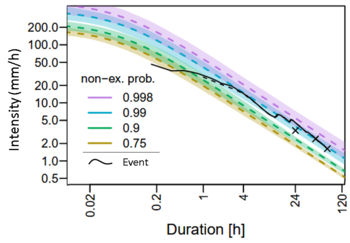IDF-AF (ClimXtreme)
Example IDF curve that shows the return levels of statistical return periods (colors) and a specific event (black).
Precipitation Extremes: Linking Consistent Intensity-Duration-Frequency Relation to Large Scale Atmospheric Flow (IDF-AF)
Precipitation events can have very different characteristics, from long-lasting light drizzle to short but intense precipitation. For every precipitation event duration, extremes can be defined using extreme value statistics, resulting in intensity-duration-frequency (IDF) relationships. A popular approach to IDF curves is the estimation of extreme value models for individual durations separately and subsequently and, in a second separate step, modelling the duration dependence for fixed quantiles (or return-levels) individually. This leads necessarily to inconsistencies such as a crossing of IDF curves associated to different quantiles (return levels): i.e. a 0.9-quantile being larger than a 0.95-quantile. We use a single consistent statistical model based on a duration-dependent Generalized Extreme Value Distribution (d-GEV) to estimate the IDF relationships for all durations simultaneously (Koutsoyiannis, 1998) and compare different approaches to model the duration dependency of the GEV (Fauer et al, 2021).
Conditional on large-scale atmospheric flow indices, IDF relationships in a changing climate are obtained locally for station-based precipitation data. Therefore, the large-scale variables time, North Atlantic Oscillation (NAO), temperature, humidty and blocking situation are used as covariates to estimate d-GEV parameters. This allows to find large-scale influence on precipitation and to create future projections of extrem precipitation, based on changes of large-scale variables.
https://climxtreme.net/index.php/en/
Publications:
Fauer, F. S., Ulrich, J., Jurado, O. E., and Rust, H. W.: Flexible and consistent quantile estimation for intensity–duration–frequency curves, Hydrol. Earth Syst. Sci., 25, 6479–6494, https://doi.org/10.5194/hess-25-6479-2021, 2021
Ulrich, J., Fauer, F. S., and Rust, H. W.: Modeling seasonal variations of extreme rainfall on different timescales in Germany, Hydrol. Earth Syst. Sci., 25, 6133–6149, https://doi.org/10.5194/hess-25-6133-2021, 2021
Dietze, M., Bell, R., Ozturk, U., Cook, K. L., Andermann, C., Beer, A. R., Damm, B., Lucia, A., Fauer, F. S., Nissen, K. M., Sieg, T., and Thieken, A. H.: More than heavy rain turning into fast-flowing water – a landscape perspective on the 2021 Eifel floods, Nat. Hazards Earth Syst. Sci., 22, 1845–1856, https://doi.org/10.5194/nhess-22-1845-2022, 2022
Caldas-Alvarez, A., Augenstein, M., Ayzel, G., Barfus, K., Cherian, R., Dillenardt, L., Fauer, F., Feldmann, H., Heistermann, M., Karwat, A., Kaspar, F., Kreibich, H., Lucio-Eceiza, E. E., Meredith, E. P., Mohr, S., Niermann, D., Pfahl, S., Ruff, F., Rust, H. W., Schoppa, L., Schwitalla, T., Steidl, S., Thieken, A. H., Tradowsky, J. S., Wulfmeyer, V., and Quaas, J.: Meteorological, impact and climate perspectives of the 29 June 2017 heavy precipitation event in the Berlin metropolitan area, Nat. Hazards Earth Syst. Sci., 22, 3701–3724, https://doi.org/10.5194/nhess-22-3701-2022, 2022
Felix S. Fauer, Henning W. Rust. Non-Stationary Large-Scale Statistics of Precipitation Extremes in Central Europe, 05 February 2023, PREPRINT (Version 1) available at Research Square, https://doi.org/10.21203/rs.3.rs-2542862/v1, 2023
